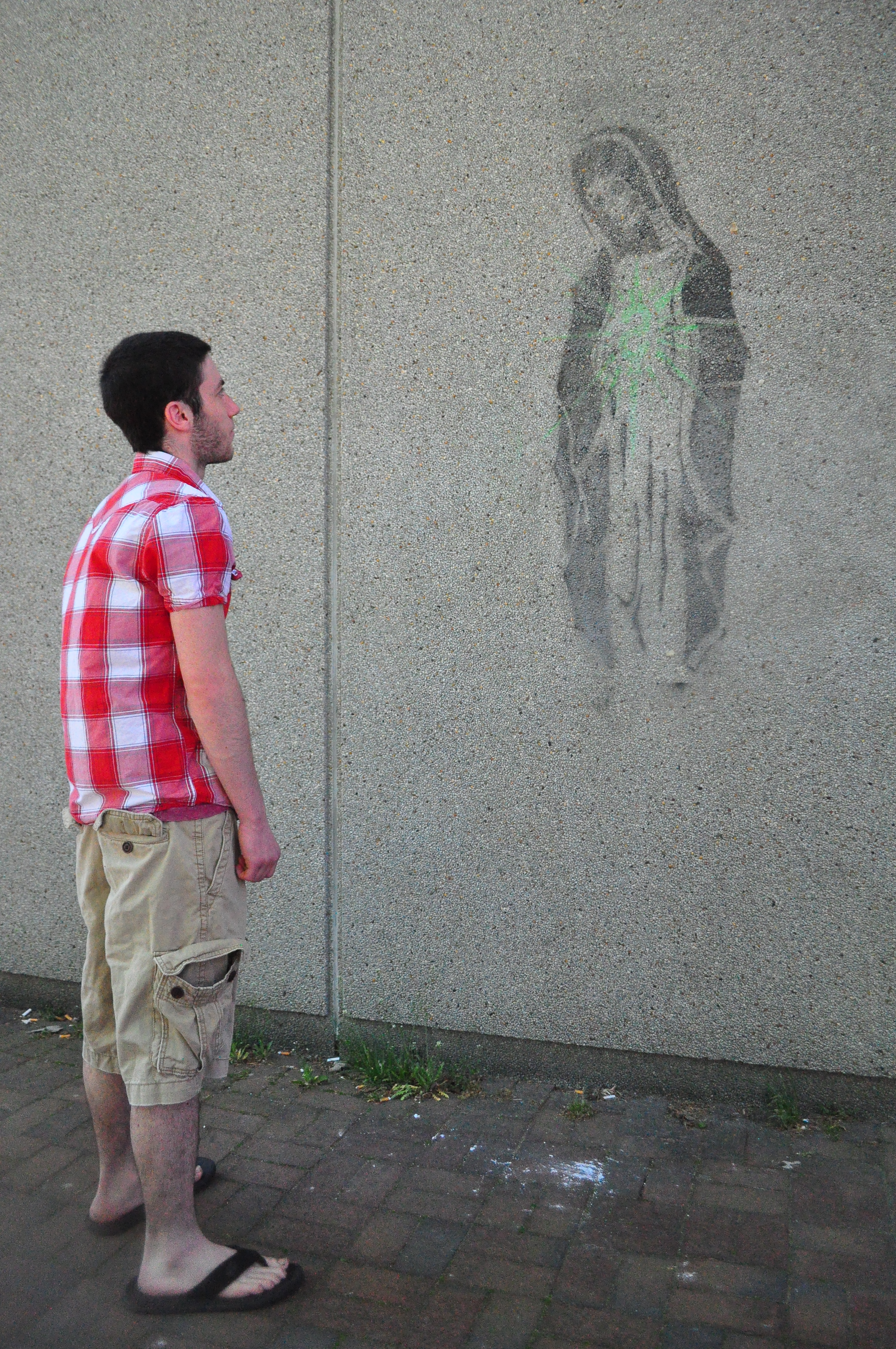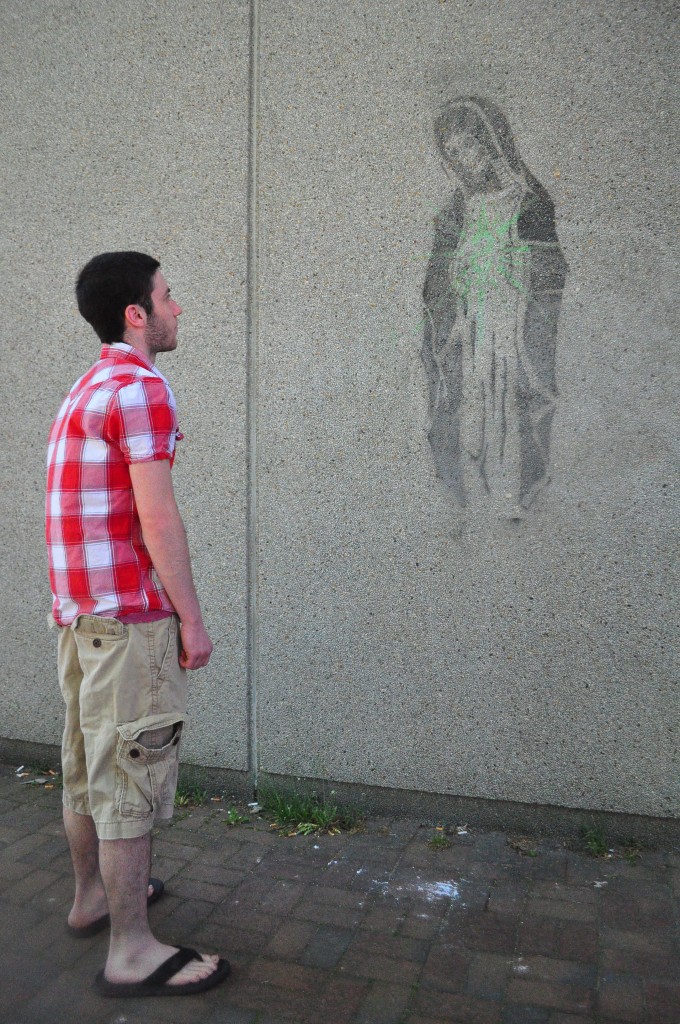

Controversy hit the front of Humanities in the form of a skeletal Virgin Mary, drawn by third-year transfer English major Aaron Kravig.
Kravig created the stenciled image as an assignment for Amy Kesselman’s Women: Images and Realities class. The assignment was to come up with a liberating action that pertained to everything he had learned about Women’s Studies. It needed to be something he would never have done in the past, had he not gained knowledge throughout the course.
“You go out and figure out what you want to do and you take direct action against what you feel,” Kravig said. “All of the ways that you learn about how women are oppressed systematically by society that are so subtle and they’ve just been here forever. It takes understanding and necessity to realize things like that.”
The general idea for the image was inspired by Banksy, who Kravig had taken a great interest in. He began looking at his work and saw the recent film about him. Kravig found himself motivated by the ideas portrayed in Banksy’s art.
“I really like how his art just has very clear messages. They’re often of great political importance and they’re relevant,” Kravig said. “They use effective illusion to things. They use stunning imagery in composition of different things in subversive ways that people can interpret in a lot of different ways.”
However, the idea for the actual image formed while Kravig was reading “The Dynamo and the Virgin” by historian Henry Adams in his American literature class. According to Kravig, the reading is essentially Adams’ reflection on attending the Worlds Fair in 1900 and seeing the dynamo, a giant electrical generator. Adams’ critique and feelings on it were that he was “viewing this giant sexless sort of entity, this being that’s neither male or female.” This represents the social normality of America that has grown from the Puritan foundations and roots, said Kravig.
Adams also reflects on touring the cathedral of Notre Dame at Chartres and despite being a Puritan, contemplates the “expanse of grandeur” of the cathedrals and how the power and influence of the Virgin is really the force that built these cathedrals.
“It’s her image that is at the very center of it, that gives people the comfort. So basically, I wanted to just make something that would sort of express all of that, something that would express also all of the things that I’ve learned in the course,” Kravig said. “Like how fucked up the world we live in is. Advertising, media, society, just turns women into a thing, an object, an illusion and when you do that, if you make a woman less than a human, then she’s a chair or like sunglasses and you can break those and they’re disposable. There’s like 900 of them, they’re all the same, it doesn’t matter.”
Kravig knew that he wanted the skeleton Mary, but was unsure of how he wanted to express the rest of it. He arrived at the answer upon looking at a Saint bracelet and focusing on the sacred heart. During this time, Kravig was constantly listening to Ke$ha and changing every “S” in a name to a dollar sign, which came into play as well.
“I was sitting around for like two months trying to think about how to express these complex ideas in an image and then it just came, the toxic green backwards dollar sign starbursted in place of the sacred heart,” Kravig said. “It’s perfect because the sacred heart of Mary is what symbolizes divinity of God and the holiness and her immaculateness, so if you take the light of God and that divinity of being and put it in terms of dollar bills, it leads to some pretty interesting contemplations on things I think and that’s the point of it.”
However, the completion of the image was not without difficulties. Kravig began in the morning and narrowly escaped through the side door he had propped open with cardboard after women in the Advising Office saw and called security. He then returned to the building a few nights later to finish the stencil. Kravig believes that Maintenance, Grounds Management and Security have not given up on removing the image though, as it has become noticeably lighter.
“Spray paint can’t be removed without pressure-washing, sand-blasting, some kind of acid treatment or more paint,” Kravig said. “If you look at it during the day when the sun hits the side of the building, you can easily see these little trails of the pressure-washer stream where they pointed it at a place on the wall next to the print.”
While security involvement was somewhat inevitable, as Kravig did not receive permission to design the image on Humanities, the controversial nature of the stencil brings about the question of whether such effort would have gone into erasing it had it depicted something else. Kravig believes that the content was definitely a factor since the ambiguity of the image’s message could potentially be offensive.
“I think that for the most part, they were more unsure about its potential for controversy, considering the incalculable variety of interpretations that can be drawn from it, which is an element that I had intended and striven for,” Kravig said.
Student responses to the piece have varied, many being unsure of the idea behind it. Second-year student Nicolette Glebatis, a member of the Campus Crusade for Christ, did not feel offended, but rather confused.
“Is it art? Is it vandalism?” Glebatis said. “I don’t know what to make of it because I know nothing about the intent of the artist, but I’d hope there isn’t a negative message behind it, as Mary is a revered figure to many Christians.”
Second-year art history major Matt Moscowitz agreed that the Virgin Mary should not be attacked, but enjoyed the imagery of it and the appeal of street art. However, he was “not in the least bit surprised that it’s tried to be erased.”
Kravig said he experienced mainly positive reactions when sitting away from it and watching people come up to examine the image, but regardless of people’s responses, Kravig felt that making the piece was “very exciting.”
“It was liberating. My whole life’s a liberating action. I’m a very liberated person,” Kravig said. “I have a lot of passions and I follow them, so I had to do something.”
